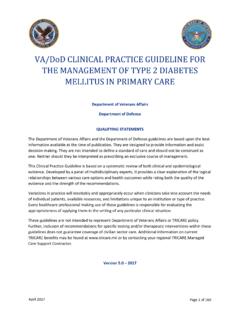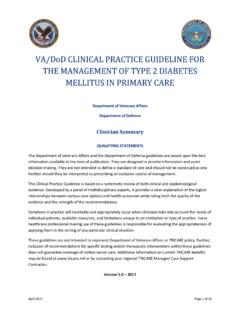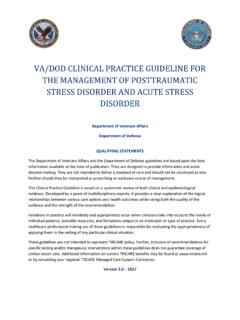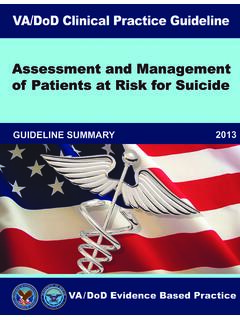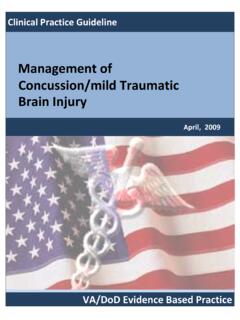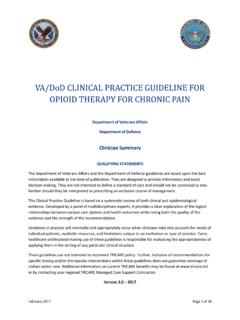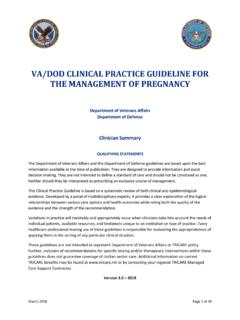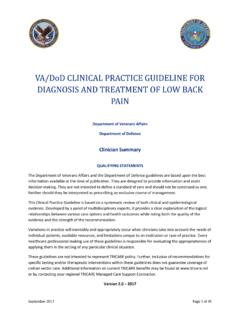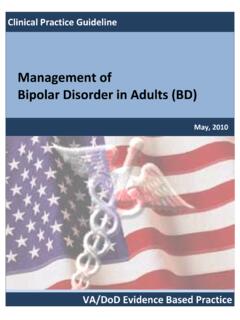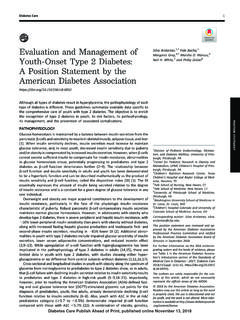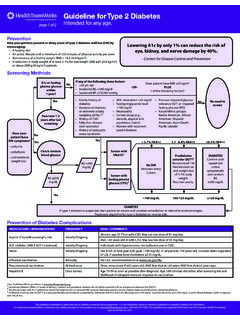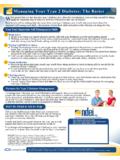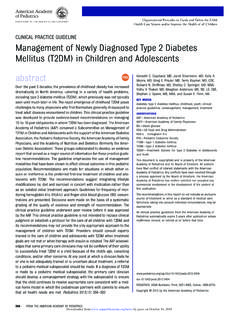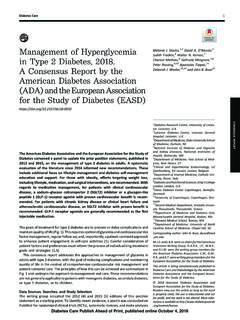Transcription of VA/DoD Clinical Practice Guideline for the Management of ...
1 April 2017 Page 1 of 13 VA/DoD Clinical Practice Guideline FOR THE Management OF TYPE 2 diabetes MELLITUS IN PRIMARY CARE Department of Veterans Affairs Department of Defense Pocket Card QUALIFYING STATEMENTS The Department of Veterans Affairs and the Department of Defense guidelines are based upon the best information available at the time of publication. They are designed to provide information and assist decision-making. They are not intended to define a standard of care and should not be construed as one. Neither should they be interpreted as prescribing an exclusive course of Management .
2 This Clinical Practice Guideline is based on a systematic review of both Clinical and epidemiological evidence. Developed by a panel of multidisciplinary experts, it provides a clear explanation of the logical relationships between various care options and health outcomes while rating both the quality of the evidence and the strength of the recommendations. Variations in Practice will inevitably and appropriately occur when clinicians take into account the needs of individual patients, available resources, and limitations unique to an institution or type of Practice . Every healthcare professional making use of these guidelines is responsible for evaluating the appropriateness of applying them in the setting of any particular Clinical situation.
3 These guidelines are not intended to represent Department of Veterans Affairs or TRICARE policy. Further, inclusion of recommendations for specific testing and/or therapeutic interventions within these guidelines does not guarantee coverage of civilian sector care. Additional information on current TRICARE benefits may be found at or by contacting your regional TRICARE Managed Care Support Contractor. Version 2017VA/DoD Clinical Practice Guideline for the Management of Type 2 diabetes Mellitus in Primary Care April 2017 Page 2 of 13 Table 1: Selected Recommendations # Recommendation Strength Category A. General Approach to T2DM Care1. We recommend shared decision-making to enhance patient knowledge and satisfaction.
4 Strong for Reviewed, New-added B. Glycemic Control Targets and Monitoring4. We recommend setting an HbA1c target range based on absolute risk reduction of significant microvascular complications, life expectancy, patient preferences and social determinants of health. Strong for Reviewed, New-added 5. We recommend developing an individualized glycemic Management plan, based on the provider s appraisal of the risk-benefit ratio and patient preferences. Strong for Reviewed, Amended 6. We recommend assessing patient characteristics such as race, ethnicity, chronic kidney disease, and non-glycemic factors ( , laboratory methodology and assay variability) when interpreting HbA1c, fructosamine and other glycemic biomarker results.
5 Strong for Reviewed, New-added 7. We recommend an individualized target range for HbA1c taking into account individual preferences, presence or absence of microvascular complications, and presence or severity of comorbid conditions (See Table 3). Strong for Reviewed, New-replaced C. Non-pharmacological Treatments12. We recommend offering therapeutic lifestyle changes counseling that includes nutrition, physical activity, cessation of smoking and excessive use of alcohol, and weight control to patients with diabetes (See VA/DoD CPGs for obesity, substance use disorders, and tobacco use cessation). Strong for Not Reviewed, Amended 13. We recommend a Mediterranean diet if aligned to patient s values and preferences.
6 Strong for Reviewed, New-added 14. We recommend a nutrition intervention strategy reducing percent of energy from carbohydrate to 14-45% per day and/or foods with lower glycemic index in patients with type 2 diabetes who do not choose the Mediterranean diet. Strong for Reviewed, New-added VA/DoD Clinical Practice Guideline for the Management of Type 2 diabetes Mellitus in Primary Care April 2017 Page 3 of 13 Module A: General Care and Treatment Abbreviations: T2DM: Type 2 diabetes mellitus *For sequential treatment of DM, see Figure 5 Target range incorporates the known variation in the HbA1c test from the laboratory used by the patient ^Use the Teach-Back Method: Tool #5.
7 Content last reviewed February 2015. Agency for Healthcare Research and Quality, Rockville, VA/DoD Clinical Practice Guideline for the Management of Type 2 diabetes Mellitus in Primary Care April 2017 Page 4 of 13 Module B: diabetes Self- Management Education VA/DoD Clinical Practice Guideline for the Management of Type 2 diabetes Mellitus in Primary Care April 2017 Page 5 of 13 Figure 1: Shared Decision-making: SHARE Approach [1] VA/DoD Clinical Practice Guideline for the Management of Type 2 diabetes Mellitus in Primary Care April 2017 Page 6 of 13 Figure 2 : The HbA1c test result and its dependence upon the assay HbA1c results should be correlated with laboratory and home blood glucose testing to ensure individualized and safe glycemic control.
8 People of African American, Hispanic, Asian and American Indian descent may have higher HbA1c values than Whites for measures of glycemic control. Persons with risk factors (ethnicity, family history) for sickle cell anemia or a thalassemia trait may also have HbA1c results that do not correlate with glycemic control. VA/DoD Clinical Practice Guideline for the Management of Type 2 diabetes Mellitus in Primary Care April 2017 Page 7 of 13 Table 2: Criteria for the diagnosis of diabetes mellitus and prediabetes [2] Status Fasting Plasma Glucose 1,2 or Hemoglobin A1c 3 diabetes Mellitus FPG 126 mg/dL ( mmol/L) on two occasionsOR HbA1c with a confirmatory FPG 126 mg/dL ( mmol/L) OR HbA1c on two occasions Prediabetes FPG 100 mg/dL and < 126 mg/dL on two occasions OR HbA1c and FPG 100 mg/dL and < 126 mg/dL ( mmol/L) OR 2- hr plasma glucose 140-199 mg/dL ( mmol/L) (IGT)Normal FPG < 100 mg/dL HbA1c < Abbreviations: dL: deciliter.
9 FPG: fasting plasma glucose; HbA1c: hemoglobin A1c; hr: hour; IGT: impaired glucose tolerance; L: liter; mg: milligram; mmol: millimole 1 Fasting is defined as no caloric intake for at least eight hours. 2 FPG is the preferred test for diagnosis, but either of the two listed is acceptable. In the absence of unequivocal hyperglycemia with acute metabolic decompensation, one of these two tests should be done on different days. 3 Using a Clinical laboratory (not a point-of-c are) methodology standardized to the National Glycohemoglobin Standardization Program (NGSP) Racial differences were reported among participants in the diabetes Prevention Program. Despite having comparable measures of glycemia, African Americans had significantly higher HbA1c levels ( ) than Whites ( ).
10 [2] VA/DoD Clinical Practice Guideline for the Management of Type 2 diabetes Mellitus in Primary Care April 2017 Page 8 of 13 Table 3: Determination of average target HbA1c l evel over time 1,2,3,4,5,12 Major Comorbidity6 or Physiologic Age Microvascular Complications Absent or Mild 7 Moderate 8 Advanced 9 Absent* > 10-15 years of Present 10 5- 10 years of life expectancy Marked 11 <5 years of life expectancy *Progression to major complications of diabetes is likely to occur in individuals with longer than 15-20 years of life , goal ranges are more beneficial early in disease in younger individuals, or healthier older adults with a longer life expectancy.
